A Brief History of Korean Animation, Part II
1967-1972: The First Wave
by Thomas Giammarco
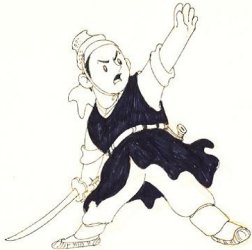
On May 16, 1961, Korea experienced a coup that left the nation under the control of a military government. This new government saw the movie industry as a business that needed to be fostered and protected and it was believed that stronger regulations would provide a means of reform. To this end, the Motion Picture Law was enacted in January of 1962 which contained some very strict rules and regulations. Believing in an expression similar to 'too many cooks spoil the broth', the government hoped to consolidate the number of production companies by making the new laws difficult for smaller companies to comply with. Thus it was that the 71 companies in existence before the law was enacted were reduced to just 16. However, even these few companies found it difficult to meet the government requirements and by June 1963, the total number of production companies in Korea had fallen to just four. (These figures come from Lee Young-il's The History Of Korean Cinema).
Another condition that had a dire effect on the Korean film industry at that time was an increase in censorship. Films were confiscated or banned on charges of being sympathetic to communism or seen as flying in the face of obscenity laws such as Yu Hyun-mok's An Empty Dream which was declared unfit for release because the lead actress bared her back. Although the early part of the 1960's is known to have a relatively large number of high-quality films or films that examined the social condition, the latter part of that decade had almost none. This can be directly linked to the intense censorship. Directors could not make films dealing with realism or providing social criticism. Ironically, this increased censoring of films is credited with the rise of the children's and teen's genre of film.
In 1965, Kim Soo-yong's children's drama Even The Sky Is Sad proved to be a huge box office success. It enjoyed an eight-week theatrical run and sold more than 270,000 tickets in Seoul alone. Unfortunately, no prints or negatives of this film are known to exist today. But, it was in 1967 that children's movies began in earnest with Space Monster Wangmagwi and Yonggary, Monster From The Deep opening in theaters. It was also the year of the first full-length animated film, Hong Gil-dong and that was soon followed by Korea's first stop-motion animation Heungbu And Nolbu.
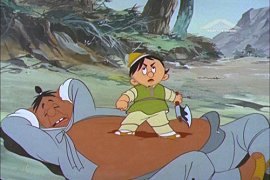 Nobody could have predicted the tremendous popularity of these films, especially Hong Gil-dong and on August 15th that same year, it was followed by Hopi And Chadol Bawi (pictured right) and a few months later by The Golden Iron Man. In early 1968, Son O-Gong opened followed by The Golden Bat, a Japanese television series passed off as a Korean/Japanese co-production (more on that soon). 1969 boasted Treasure Island and General Hong Gil-dong, 1971 saw the releases Prince Hodong and the Princess Of Nakrang and Lightning Atom, followed by War of the Monsters in 1972.
Nobody could have predicted the tremendous popularity of these films, especially Hong Gil-dong and on August 15th that same year, it was followed by Hopi And Chadol Bawi (pictured right) and a few months later by The Golden Iron Man. In early 1968, Son O-Gong opened followed by The Golden Bat, a Japanese television series passed off as a Korean/Japanese co-production (more on that soon). 1969 boasted Treasure Island and General Hong Gil-dong, 1971 saw the releases Prince Hodong and the Princess Of Nakrang and Lightning Atom, followed by War of the Monsters in 1972.
With each new release, the audience grew smaller. The main reason for this is seen today to be the growing number of black-and-white televisions in Korean households. This lowly device not only brought the animation industry to its knees, it had a devastating effect on the entire movie industry. During this time, classic MGM cartoons as well as Japanese animation were being imported for the entertainment of Korean children and the movie industry recognized that its audience was being drained away as evident by the writing on the flyer of Prince Hodong and The Princess Of Nakrang. It said, "This film is more fun than a TV cartoon. It's longer and more exciting! Besides that, it's in living color!"
Although the advertisement correctly pointed out some of the shortfalls of watching cartoons on TV as compared to seeing a full-color animated movie, the people at the time did not agree and the crisis the industry was facing eventually grew to a point where between the release of War Of The Monsters in 1972 and the release of Robot Taekwon V in 1976, there were no Korean animated films at all.
Hong Gil-dong, Hopi And Chadol Bawi, General Hong Gil-dong and Prince Hodong and the Princess Of Nakrang were all based on traditional legends and folk stories, however each contained elements that made them unique. The characters of the Hong Gil-dong series were all based on Heo Gyun's "The Legend Of Hong Gil-dong" and artist Shin Dong-woo's comic "Hong Gil-dong The Hero." Another movie released at this time, The Golden Iron Man, was also based on a comic strip that appeared regularly in The Chosun Boys' Journal and, of course, Treasure Island was based on the famous book by Robert Louis Stevenson. Therefore, all of these early animated films were based on characters or stories that would have been familiar to Korean movie-goers which, no doubt, helped contribute to their success in the box office. Choosing familiar themes also guaranteed that investors could be attracted to the production while they might otherwise shy away from an original work.
Hong Gil-dong
In the time prior to Hong Gil-dong's release, Disney was nearly the only company exporting animated films for theatrical release into Korea. The importing and distribution were handled by Seki Productions -- the company that produced Hong Gil-dong. Seki Productions was re-introducing classic films such as Snow White And The Seven Dwarves and Peter Pan to a new generation and the movies were enjoying considerable success. This success is what prompted Seki Productions to take the plunge and create their own animated movie.
The screen quota system introduced earlier was another reason that Seki was anxious to create its own cartoon. In 1965, more than 200 Korean films were being produced while the number of foreign films coming into the country was about a third of that number. The new screen quota laws passed at that time required some movie theaters which generally played foreign films to screen Korean movies 60-90 days out of the year. Seki Productions, which owned many of those theaters, wanted something exciting to run during those two or three months for fear of losing a considerable amount of revenue, and they turned to animation as the answer to their dilemma.
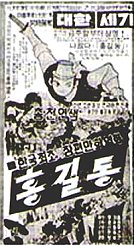 There was one more factor that influenced Seki Productions to dive into the children's genre as a source of income. As mentioned earlier, an increase in censorship had accompanied the new Motion Picture Law. However, children's movies were not subject to the same scrutiny as other films. Therefore, the filmmakers believed that they would have more artistic freedom than they would normally have.
There was one more factor that influenced Seki Productions to dive into the children's genre as a source of income. As mentioned earlier, an increase in censorship had accompanied the new Motion Picture Law. However, children's movies were not subject to the same scrutiny as other films. Therefore, the filmmakers believed that they would have more artistic freedom than they would normally have.
So it was on January 21, 1967 that Hong Gil-dong was released into theaters from Seoul to Busan, and it ran until February 8th only to be released again later in August of the same year. The director, Shin Dong-heon and his young brother, the creator of the "Hong Gil-dong The Hero" comic strip, Shin Dong-won (1936-1995), had planned to release it over the Chuseok holiday in 1966, but the producers nixed that idea after previewing the film. The release was delayed and the brothers were ordered to make some improvements. Quite a bit of confusion and exaggeration surrounded the release of this film. For example, the January 15th 1967 edition of the Seoul Newspaper reported that the film took 8 months to complete. However, on that same day, the Chosun Ilbo reported that it took two years to finish. It seems as if the Chosun Ilbo provided the correct information in this case as director Ju Yeong, then a student of Shin Dong-woo, recalled in the magazine Animatoon (no. 28, 2000) that he was working on the demo of Hong Gil-dong in 1964.
It is also printed on the poster that this film was "150 times longer than the height of Namsan Mountain and cost 54 million won -- as much as ten other Korean films!" But the Chosun Boys' Journal and the Dong-a News reported that the film cost an estimated 20 million. Since Hopi And Chadol Bawi released later that same year had a price tag of W10 million and Robot Taekwon V, made a decade later, cost W45 million, it seems that the figures reported in the newspapers were more accurate.
Another area where inconsistencies abound is concerning how many people worked on the film. The Seoul Newspaper reported that it was completed with 75 animators, 25 colorists and 6 cameraman. The Dong-a Ilbo and Korea Ilbo reported that 50 animators and 130 colorists were employed and Shin Dong-heon said in the Chosun Boys' Journal that he had 32 assistants and 8000 technicians!
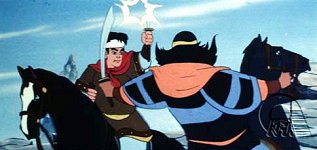 Regardless of the fact that newspapers could not agree on how many people it took to make, they all agreed that Hong Gil-dong was a huge success. All the papers gleefully followed the number of tickets sold and reported the results daily. After two days, 45,982; after three days 63,297; on the fourth day, the number was nearly 100,000 and by the sixth day, the figure stood at about 120,000 tickets sold. Jo Min-cheol, the cinematographer who worked on Hong Gil-dong stated in Animatoon #28 that he thought that the final number of tickets sold was somewhere around 380,000, however that interview took place more than three decades after the fact and his memory may not have been accurate. Since the number of tickets sold that year for Kang Dae-jin's Theater Of Youth, the film known to have sold the most tickets in 1967, is reported as selling 150,000, it stands to reason that Hong Gil-dong, which landed in the number two position that year, sold less. However, even at number two, the film was a triumph.
Regardless of the fact that newspapers could not agree on how many people it took to make, they all agreed that Hong Gil-dong was a huge success. All the papers gleefully followed the number of tickets sold and reported the results daily. After two days, 45,982; after three days 63,297; on the fourth day, the number was nearly 100,000 and by the sixth day, the figure stood at about 120,000 tickets sold. Jo Min-cheol, the cinematographer who worked on Hong Gil-dong stated in Animatoon #28 that he thought that the final number of tickets sold was somewhere around 380,000, however that interview took place more than three decades after the fact and his memory may not have been accurate. Since the number of tickets sold that year for Kang Dae-jin's Theater Of Youth, the film known to have sold the most tickets in 1967, is reported as selling 150,000, it stands to reason that Hong Gil-dong, which landed in the number two position that year, sold less. However, even at number two, the film was a triumph.
Critics and advertisements heaped praise on Korea's first full length animation. One ad claimed, exaggerating slightly, "Korea joins America, France, Germany and Japan as one of only five nations of the world capable of making animated pictures!" while another exclaimed with relatively more modesty, "A brilliant animation that everyone in your family will love!"
Other Productions
The first stop-motion animation Heungbu and Nolbu opened in theaters six months after Hong Gil-dong on June 30, 1967. It was an amazing film based on a traditional tale of two brothers, one poor but kind and the other rich but selfish and cruel. However, enough new ideas were added to the story to increase its interest factor such as the Kingdom of the Swallows, a very angry dragon, and an animal chorus told using dolls reminiscent of the Raskin/Bass holiday specials. Mixed in at appropriate times is traditional 'opera' (or pansori). The technique of animating dolls began in Europe and made its way to Japan where it was very popular. Kang Tae-woong, the director of Heungbu And Nolbu, studied the art of stop motion animation while working on Miyoji Ieki's Kurohima Story which was also released in 1967.
Newspapers promoted the film as 'The World's First Full-Length Stop Motion Animation!'--but that was inaccurate to say the least. Meanwhile, the Gyeonghyang Newspaper praised the use of pansori and the amazing dolls saying, "These mechanical dolls seem to actually cry and change expressions." While critics loved the film, the audience response, perhaps due to the familiarity of the story, was less enthusiastic and no film would be made using doll animation until Kang Tae-woong made another folktale, Kongjwi Patjwi in 1978.
The film screened two more times that year, once in conjunction with The Princess' First Love starring Nam Jeong-im. It also received a special screening in 2005 at the Korean Film Archive (KOFA). The Korean Film Archive also lists this film as winning an award at the 5th Blue Dragon Awards for best tragedy--an odd category for it to be competing in. It was later released at the 14th Asia Film Festival.
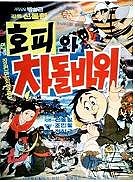 Hopi and Chadol Bawi (pictured right), Shin Dong-heon's sequel to Hong Gil-dong received a theatrical release on August 15, 1967. However, before beginning work on the project, Shin had disassociated himself from Seki Productions--a turn of events that left Seki rather bitter, and confusing ownership issues allowed Seki Productions to make a 'true sequel' to the highly successful original called General Hong Gil-dong in 1969.
Hopi and Chadol Bawi (pictured right), Shin Dong-heon's sequel to Hong Gil-dong received a theatrical release on August 15, 1967. However, before beginning work on the project, Shin had disassociated himself from Seki Productions--a turn of events that left Seki rather bitter, and confusing ownership issues allowed Seki Productions to make a 'true sequel' to the highly successful original called General Hong Gil-dong in 1969.
Hopi revolved around two supporting characters from the Hong Gil-dong comic and movie--the young axe-wielding Chadol Bawi and the lone thief with the potential for good nicknamed Hopi (literally 'tiger skin') after the clothes he wore. Hong Gil-dong makes no appearance. The atmosphere of the film managed to capture the feeling of a period film that was often made at that time but, because it was an animation, could include many elements that would have been difficult to depict on screen such as the battle with the flying Goblin King and the sleek, highly stylized wolves.
According to the August 8, 1967 edition of the Chosun Ilbo, the 75-minute movie consisted of some 5000 frames and cost about 10 million won to produce. It only took six to seven months to complete.
It went on to become the first Korean animation to be exported. It was screened in Taiwan in 1969 and, much later, appeared at the 3rd Tehran Children's Film Festival. Seki's next production, Son O-gong, bears the dubious distinction of being the first animated failure. Director Han Seong-hak recalled in a 1999 interview in Animatoon that it was criticized as being childish, technically inferior and poorly edited. He did not dispute these claims but said that the cause could be traced to the very short production time they were given.
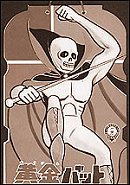 The Golden Bat (pictured left) was released in the summer of 1968. Many websites dealing with Korean animation, and even the Korean Film Archive's database, list this film as a Korean-Japanese co-production, however this is not the case. Although upon its release in Korean theaters, it was labelled as a Shin Sang-ok Production, it was in name only. This is explained in Heo In-wook's The History Of Korean Animated Movies. The Golden Bat was actually a Japanese television series that TBC-TV purchased to broadcast in Korea and it proved to be fairly popular. So, episodes 1-4 were cobbled together to create a 'movie' and it played in theaters during the summer break.
The Golden Bat (pictured left) was released in the summer of 1968. Many websites dealing with Korean animation, and even the Korean Film Archive's database, list this film as a Korean-Japanese co-production, however this is not the case. Although upon its release in Korean theaters, it was labelled as a Shin Sang-ok Production, it was in name only. This is explained in Heo In-wook's The History Of Korean Animated Movies. The Golden Bat was actually a Japanese television series that TBC-TV purchased to broadcast in Korea and it proved to be fairly popular. So, episodes 1-4 were cobbled together to create a 'movie' and it played in theaters during the summer break.
Although at that time in history, The Golden Bat--a mysterious crime-fighter--could in no way be considered a Korean cartoon, the character was adopted and would later appear again in a true Korean production Black Star and the Golden Bat in 1979 where his costume had change to appear much more Batman-like. He would also be made into a live-action character in Young-gu And The Golden Bat in the early 1990's.
At the same time as The Golden Bat was disappointing children who had already seen the episodes on TV, Korea's first animated science fiction film was being screened. Conscious of The Golden Bat's origin, posters for The Golden Iron Man, directed by Park Yeong-il, proclaimed that this new film was "Not A Television Cartoon! It's A Real Cartoon Movie!" One of the theaters, in an effort to increase ticket sales, raffled off vacation packages to 60 people and gave away thousands of posters. It was reported that the movie would be sold out an hour before each showing, and proved to be so popular that it was exported to Japan in the following year.
For the 1969 summer holidays, Seki Productions prepared their own sequel to the Hong Gil-dong series, General Hong Gil-dong directed by Yong Yu-su. Still bitter over Shin Dong-heon's departure, the film's promotion campaign declared it the 'true' sequel to Hong Gil-dong and "far more interesting than the original." 1969 was also the year that the Korean production of Treasure Island was released. Other than the fact that the story was told using animals, the plot did not differ from Stevenson's novel. Ten years later, the film would be remade by director Song Jeong-hun as Animal Treasure Island.
Seki continued to dominated the market for animated films by releasing all of the next three films. These would be the last cartoons made in Korea until Robot Taekwon V opened in theaters in 1976. The first was Prince Hodong And The Princess Of Nakrang (1971) which promised to make viewers cry and "laugh your belly button off." It cost W30 million to make and the expressed intent was to export it to "gain the admiration of foreigners -- both adults and children." However, competition from television proved to be too great and it was not even able to gather a domestic audience.
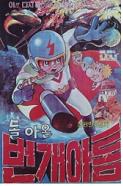 Yong Yu-su's next work (pictured right) was based on Osamu Tezuki's character Tetsuwan Atom, known to Western audiences as "Astro Boy." However, although the name, Lightning Atom, was similar, the character design and story were quite different from the Japanese production. However, the next animation, released in 1972 clearly received a signifigant amount of influence from the Japanese Ultraman series and giant monster movies like Godzilla and Gamera. It was called War Of The Monsters. Although little interest was shown in this film when it was released, War Of The Monsters screened on three separate occasions in 2005.
Yong Yu-su's next work (pictured right) was based on Osamu Tezuki's character Tetsuwan Atom, known to Western audiences as "Astro Boy." However, although the name, Lightning Atom, was similar, the character design and story were quite different from the Japanese production. However, the next animation, released in 1972 clearly received a signifigant amount of influence from the Japanese Ultraman series and giant monster movies like Godzilla and Gamera. It was called War Of The Monsters. Although little interest was shown in this film when it was released, War Of The Monsters screened on three separate occasions in 2005.
Between the closing of War Of The Monsters in 1972 and the release of Robot Taekwon V in 1976, there were no Korean-made animations. That is not to say that audiences were deprived of cartoons. Disney continued to export its films into Korea and a Hong Kong animation, Bong Shin Bong (The Story Of Chinese Gods) was shown in cinemas and was very popular because the main character was patterned after Bruce Lee. Korean television would rely on foreign made cartoons for more than a decade more, producing the first Korean cartoon series in 1987. MGM continued to send their classic animation, like Tom And Jerry, to Korea and numerous Japanese cartoons appeared on television. These proved to be very successful, especially one called Mazinga Z. Mazinga Z was the giant robot which led to the creation of Robot Taekwon V and a new era of Korean animated films.